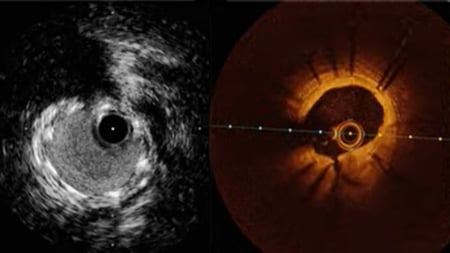Long‐term safety of paclitaxel drug‐coated balloon‐only angioplasty for de novo coronary artery disease: the SPARTAN DCB study
Selected in Clinical Research in Cardiology by A. Bharadwaj , M. Alasnag
This study adds to the growing body of evidence demonstrating that DCB is a safe option for the treatment of de novo coronary lesions with NO signal towards increase in mortality up to 5-year follow-up.
References
Authors
I Merinopoulos, T Gunawardena, U Wickramarachchi, P Richardson, C Maart, S Sreekumar, C Sawh, T Wistow, T Sarev, A Ryding, T Gilbert, A Perperoglou, VS Vassiliou, SC Eccleshall
Reference
Clin Res Cardiol . 2020 Sep 2. Online ahead of print.
Published
2 September 2020
Link
Read the abstractReviewers
Our Comment
Why this study? – the rationale/objective
Drug coated balloon (DCB) is a promising technology for the treatment of coronary and peripheral artery disease. However, a recent meta-analysis raised concerns about the safety of DCB when used for treatment of peripheral artery disease leading to an investigation by the Food and Drug Administration (FDA). There was a suggestion towards increase in late mortality related to the paclitaxel dose-time product.1 Although the dose of paclitaxel in coronary DCB is of much lower magnitude compared to the dose in peripheral DCB, there is no data regarding long term mortality. The objective of this study was to investigate whether there was a signal towards increased mortality in patients treated with paclitaxel-coated DCB for de-novo coronary lesions with up to 5 years follow-up.
How was it executed? – the methodology
The long-term Safety of PAclitaxel dRug coaTed balloon only ANgioplaSty for de novo coronary artery disease (SPARTAN DCB) study is a retrospective study where data was collected from the clinical database at Norfolk and Norwich University Hospital, UK. It included patients treated with either paclitaxel DCB or 2nd-generation non-paclitaxel Drug Eluting Stents (DES) for stable, de novo coronary lesions between 1st January 2011 and 31st December 2018. Patients presenting with STEMI, NSTEMI, prior PCI or patients treated with a combination of both DCB and DES in subsequent PCIs were excluded from the study. Data was analyzed with Cox regression statistical models and Kaplan-Meier curves.
What is the main result?
Of the 1517 patients included in the analysis 429 were treated with paclitaxel DCB and 1088 with non-paclitaxel 2nd generation DES. On univariate analysis a number of co-morbidities such as age, dyslipidemia, hypertension, peripheral vascular disease, prior myocardial infarction, heart failure, smoking, atrial fibrillation, decreasing estimated glomerular filtration rate (eGFR) and renal failure (eGFR < 45) were associated with worse survival. Compared with DES, DCB was noted to have a non-significant trend (p= 0.08) towards better prognosis. On multivariate analysis age, decreasing eGFR and smoking were associated with a worse prognosis. In conclusion, there was no evidence of late mortality associated with the use of paclitaxel DCB compared with non-paclitaxel 2nd generation DES for the treatment of de novo coronary lesions in up to 5 years follow-up.
Critical reading and the relevance for clinical practice:
Drug-Coated Balloons offer the unique advantage of delivering an anti-proliferative agent without implanting any metal in the coronary lesion being treated. It is to be noted that the role of DCB in the treatment of in-stent restenosis (ISR) has been well established. A recent large meta-analysis demonstrated that DCBs are equivalent to repeat Drug-Eluting Stent (DES) implantation for the treatment of Bare Metal Stent (BMS) ISR; however, they are less effective than repeat DES stenting in the treatment of DES ISR.2
Other studies evaluating the role of DCB in the treatment of de-novo coronary lesions have also shown favourable results and they include the following:
- The BASKET-SMALL 2 was a multicenter randomized trial (N= 758), which demonstrated that DCB was non-inferior to DES with respect to MACE up to 12 months in de novo coronary lesions < 3 mm in diameter.3
- The DEBUT Trial a randomized multicenter trial from Finland (N= 220) demonstrated that DCB is superior to BMS in the treatment of de novo coronary lesions in patients with elevated bleeding risk.4
- REVELATION Trial was a randomized single-centre trial (N= 120) from the Netherlands, which evaluated DCB versus DES in non-calcified STEMI culprit lesions with < 50% residual stenosis after pre-dilatation. DCB was found to be safe and feasible, and non-inferior to DES in terms of fractional flow reserve assessed at 9 months.5
In the context of all the encouraging data summarized above, the current study by Vassiliou et al adds to the growing body of evidence demonstrating that DCB is a safe option for the treatment of de novo coronary lesions with NO signal towards increase in mortality up to 5-year follow-up.
References
1 Risk of death following application of paclitaxel-coated balloons and stents in the femoropopliteal artery of the leg: a systematic review and meta-analysis of randomized controlled trials. Katsanos K, Kitrou P, Karnabatidis D et al (2018), J Am Heart Assoc
2 Drug-Coated Balloon Angioplasty Versus Drug-Eluting Stent Implantation in Patients With Coronary Stent Restenosis. Giacoppo et al, J Am Coll Cardiol. 2020 Jun, 75 (21) 2664-2678
3 Drug-coated balloons for small coronary artery disease (BASKET-SMALL 2): an open-label randomised non-inferiority trial. Jeger RV, Farah A, Ohlow M et al (2018), Lancet 6736:1–8
4 Drug-coated balloon for treatment of de-novo coronary artery lesions in patients with high bleeding risk (DEBUT): a single-blind, randomised, non-inferiority trial. Rissanen TT, Uskela S, Eränen J et al (2019), Lancet 6736:1–10
5 Paclitaxel-Coated Balloon Angioplasty Versus Drug-Eluting Stent in Acute Myocardial Infarction. Vos NS, Fagel ND, Amoroso G et al (2019), JACC Cardiovasc Interv 9:1691–1699







No comments yet!